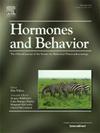催产素和共同意向性与儿童合作正相关
IF 2.5
3区 医学
Q2 BEHAVIORAL SCIENCES
引用次数: 0
摘要
虽然人类与无关个体合作的程度远远超过其他物种,但我们在决定是否合作时也表现出极大的差异。认知、情感、社会和生理机制的多样性相互作用,形成了这些决定。例如,在一个以迭代囚徒困境为模型的最佳觅食范例中,群体成员资格、共同的意向性谈话(即关于共同目标的谈话)和自然的初始催产素水平与成人的合作有关。在这个 "寻蛋游戏 "中,共同的意向性谈话是实现合作的关键,它更多地推动了具有相同组员身份(初始催产素水平也较高)的参与者之间的合作。这种复杂的交互作用提出了一个问题:人类在什么年龄阶段会发展出必要的机制,从而在 "寻蛋 "游戏中进行有效的合作?在这里,我们对 10 至 14 岁的中学生进行了测试。我们发现,与成人一样,共同的意向性谈话是成功合作的关键。此外,最初的催产素水平与通过共同意向性谈话进行的合作相关。相比之下,小组成员资格并不影响行为。最后,实验前和实验后的催产素水平与小组成员资格和性别有不同的交互作用。因此,儿童的表现与成人相对相似,但在潜在机制方面却存在一些差异。我们的研究为进一步了解催产素在青少年早期社会行为中的作用做出了难得的贡献。本文章由计算机程序翻译,如有差异,请以英文原文为准。
Oxytocin and shared intentionality are positively associated with cooperation in children
While humans cooperate with unrelated individuals to an extent that far outstrips any other species, we also display extreme variation in decisions about whether to cooperate or not. A diversity of cognitive, affective, social, and physiological mechanisms interact to shape these decisions. For example, group membership, shared intentionality talk (i.e. talk about shared goals), and natural initial oxytocin levels are linked to cooperation in adults in an optimal foraging paradigm that is loosely modelled on the iterated prisoner's dilemma. In this ‘egg hunt’, shared intentionality talk was key to achieving cooperation, and it drove cooperation more between participants who shared the same group membership (and who also had higher initial oxytocin levels). Such complex interactions raise the question of the age at which humans develop the necessary mechanisms to cooperate effectively in the egg hunt game. Here, we tested children in secondary school aged between 10 and 14 years. We found that, as for adults, shared intentionality talk was crucial for successful cooperation. Furthermore, initial oxytocin levels correlated with cooperation through shared intentionality talk. In contrast, group membership did not affect behaviour. Finally, pre- and post-experiment oxytocin levels showed various interactions with group membership and sex. Thus, children's performance was relatively similar to adults while showing some differences with respect to underlying mechanisms. Our study is a rare contribution to further our understanding of the role of oxytocin in early adolescent social behaviour.
求助全文
通过发布文献求助,成功后即可免费获取论文全文。
去求助
来源期刊

Hormones and Behavior
医学-行为科学
CiteScore
6.70
自引率
8.60%
发文量
139
审稿时长
91 days
期刊介绍:
Hormones and Behavior publishes original research articles, reviews and special issues concerning hormone-brain-behavior relationships, broadly defined. The journal''s scope ranges from laboratory and field studies concerning neuroendocrine as well as endocrine mechanisms controlling the development or adult expression of behavior to studies concerning the environmental control and evolutionary significance of hormone-behavior relationships. The journal welcomes studies conducted on species ranging from invertebrates to mammals, including humans.
 求助内容:
求助内容: 应助结果提醒方式:
应助结果提醒方式:


